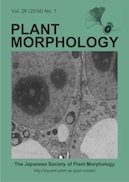Volume 26, Issue 1
Displaying 1-14 of 14 articles from this issue
- |<
- <
- 1
- >
- >|
Cover
-
2014Volume 26Issue 1 Pages 0
Published: 2014
Released on J-STAGE: April 21, 2015
Download PDF (3710K)
Breakthrough of plant science by new image information
-
2014Volume 26Issue 1 Pages 1-2
Published: 2014
Released on J-STAGE: April 21, 2015
Download PDF (1608K) -
2014Volume 26Issue 1 Pages 3-8
Published: 2014
Released on J-STAGE: April 21, 2015
Download PDF (2281K) -
2014Volume 26Issue 1 Pages 9-12
Published: 2014
Released on J-STAGE: April 21, 2015
Download PDF (5800K) -
2014Volume 26Issue 1 Pages 13-17
Published: 2014
Released on J-STAGE: April 21, 2015
Download PDF (1358K) -
Elemental imaging of biological samples with high lateral resolution secondary ion mass spectrometry2014Volume 26Issue 1 Pages 19-23
Published: 2014
Released on J-STAGE: April 21, 2015
Download PDF (3069K) -
2014Volume 26Issue 1 Pages 25-30
Published: 2014
Released on J-STAGE: April 21, 2015
Download PDF (3937K) -
2014Volume 26Issue 1 Pages 31-35
Published: 2014
Released on J-STAGE: April 21, 2015
Download PDF (2716K)
Minireview
-
2014Volume 26Issue 1 Pages 37-43
Published: 2014
Released on J-STAGE: April 21, 2015
Download PDF (4017K) -
2014Volume 26Issue 1 Pages 45-51
Published: 2014
Released on J-STAGE: April 21, 2015
Download PDF (1580K) -
2014Volume 26Issue 1 Pages 53-58
Published: 2014
Released on J-STAGE: April 21, 2015
Download PDF (2917K) -
2014Volume 26Issue 1 Pages 59-63
Published: 2014
Released on J-STAGE: April 21, 2015
Download PDF (1816K) -
2014Volume 26Issue 1 Pages 65-70
Published: 2014
Released on J-STAGE: April 21, 2015
Download PDF (3867K)
Poster Abstract
-
2014Volume 26Issue 1 Pages 71-85
Published: 2014
Released on J-STAGE: April 21, 2015
Download PDF (2203K)
- |<
- <
- 1
- >
- >|
